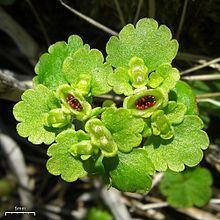Rank Species | ||
 | ||
Similar Chrysosplenium, Ribes hudsonianum, Aconitum noveboracense, Chrysosplenium oppositifolium, Chrysosplenium japonicum | ||
Chrysosplenium iowense is a species of flowering plant in the saxifrage family known by the common name Iowa golden-saxifrage. It is native to North America, where it is "primarily a Canadian species", occurring from the northern Northwest Territories south to British Columbia and east to Manitoba. There are also disjunct, relictual occurrences within the United States, in the Driftless Area of Minnesota and Iowa.
This plant is a stoloniferous herb with erect stems up to 15 centimeters tall. Flowering stems are not produced during the first season. Leaves occur on the stolons and the stems. They have five to nine lobes around the edges. The inflorescence is a cyme of up to 12 flowers with leaflike yellow-green bracts and small yellow or greenish sepals. The production of flowers varies by temperature, with the maximum flowering occurring when the substrate is around 11 to 12°C. Plants require insects for pollination. The cuplike fruit capsule contains many reddish seeds.
Habitat types include wet and moist streambanks and woods. In the southern part of its range this northern species occurs and persists in spots that are always cool to cold, such as ice caves and tunnels carrying cold air. Associated plants include Abies balsamea, Acer spicatum, Adoxa moschatellina, Betula alleghaniensis, Carex media, Carex peckii, Circaea alpina, Cornus canadensis, Equisetum scirpoides, Linnaea borealis, Lycopodium spp., Maianthemum canadense, Mertensia paniculata, Rhamnus alnifolia, Ribes hudsonianum, Taxus canadensis, Trillium nivale, and Viburnum trilobum.
Populations of this plant are generally small, containing no more than a few hundred individuals.
Threats to this species include trampling and other disturbance by humans and cattle. Logging is a threat for several reasons; the machinery damages the habitat and the process of logging leads to the succession of woody vegetation, erosion, and changes in shade and hydrology. Agriculture also alters the habitat. In Alberta the plant grows in areas with busy oil and gas exploration activity. Some sources consider this species as C. alternifolium var. sibiricum.
